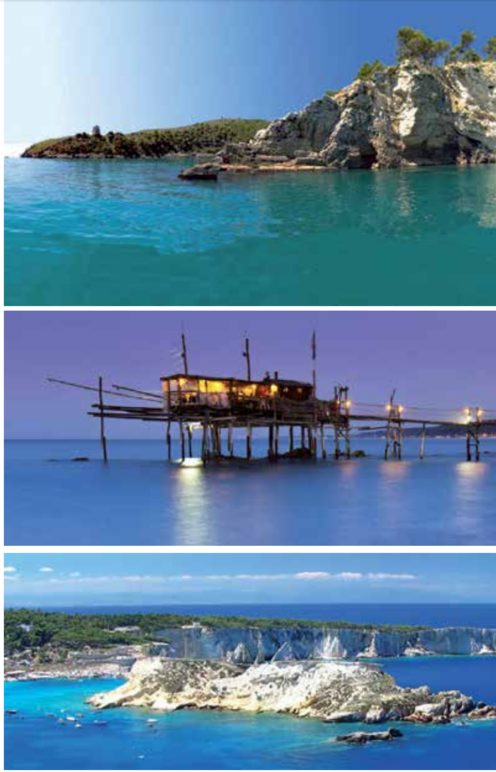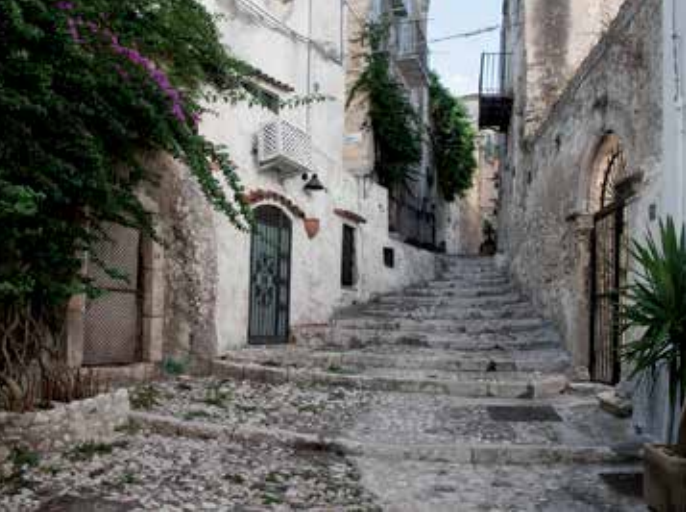Gargano: An Intriguing Spot in Apulia
From the gates of L’Aquila, the beautiful capital of Abruzzo, the ancient cattle-trail led all the way to the city of Foggia in Puglia. Over 300 feet wide and 150 miles long, it was the largest and most important of the five trails connecting Abruzzo with Puglia. For that reason it was known as the Great Cattle-Trail (‘Tratturo Magno’); an arterial road leading the essential traffic of enormous herds of sheep in transhumance towards Puglia’s flat lands. Guided by their shepherds, the sheep descended from the mountains of Gran Sasso, Sirente and Majella to reach the green pastures of Tavoliere delle Puglie, the great and boundless plain at the foot of Gargano. Millions of sheep would descend each year from the plateaus of Abruzzo and Molise to spend their winters there, always finding fresh grass to feed on.
Two thousand years of transhumance
“September’s come, let’s go: migration time. In the Abruzzi lands my shepherds now are leaving their summer folds: down they climb” (tr. Geoffrey Brock). So begins the charming poem by Gabriele D’Annunzio. The shepherds indeed left with their herds in September, walking for days and days on the route marked out by centuries, dating back to even before the domination of Rome. On reaching the Adriatic Sea and Tavoliere delle Puglie the herds and their shepherds would stay for the whole winter until April, sleeping under the starlit sky. Throughout the long and tiresome journey from the high plateaus, both the animals and their shepherds would often rest next to churches and other places of worship.
When the first shepherd noticed the sea on the horizon his heart would jump with joy, and then they would continue to walk for days along the marvelous coastline bathed by the emerald Adriatic Sea. Yet the greatest joy for the shepherds was when the green Gargano Promontory could be seen looming on the horizon, like an announcement of their imminent arrival at the final destination. For two millennia, this great highway of earth and grass has united the transhumance of Abruzzo with Tavoliere of Puglia, nourishing a combination of greatly impressive cultures and traditions.
From Tavoliere to Gargano
The foothills of Gargano begin precisely from Tavoliere—once the land of the ancient Dauni people. This wide, limestone mass creates the perfect shape of a spur on the boot-shaped map of Italy. A vast forest of beech, maple, oak and holm oak trees overlooks the promontory; a green paradise of flora and fauna, today a National Park known as the Foresta Umbra (or Shaded Woods). From the summit of Mount Calvo, 3,460 feet high, the Gargano Promontory often appears to be right on the edge the sea, decorating the coastline with enchanting rocky coves, embroidered by waves, with caves, gorges, cliffs and deep valleys. As a result of these natural marvels and the beauty of the villages that line the shores, the coast is a strong attraction for beach tourism.
Tourists and vacationers alike can enjoy the crystal clear waters, the charming villages and the cheerful and welcoming characters of the people who live there. They can also enjoy a richness of flavors from a simple yet ancient cuisine and a prolific flourishing of architecture that tells a thousand-year old history, a place so full of culture and strong spirituality.
The calcareous nature of Gargano’s land means that little can be used for agriculture. Strips of earth have been allocated to the cultivation of olive groves and grapevines, providing good wines like the typical “Trojan Black” (Nero di Troia), and on the coast there are also citrus groves. Vegetable crops are only grown on the foothills of the promontory and on the shores of Lake Lesina and Lake Varano, almost touching the sea.
From here we will begin our circumnavigation around the marvels of Gargano, travelling along the coastal road that follows the contour of the promontory, until we reach Manfredonia. We will then go from Mattinata to Monte Sant’Angelo, then to San Giovanni Rotondo before descending to San Marco in Lamis and ending in San Severo.
A tangle of pretty little villages
The narrow and winding road to Rodi Garganico, a beautiful village nestled on a rocky cliff, will certainly keep you awake. This populous seaside town features a maze of alleyways and is dominated by the Castle and the Church of Santa Maria della Libera, inside of which a beautiful byzantine image of the Virgin Mary can be found. From the marina, hydrofoils depart for the magnificent Tremiti Islands, five small gems of the Adriatic. A little beyond Rodi Garganico you will reach Peschici; old walls surround this ancient village of gray-domed houses, grouped together on an outcrop overlooking the sea.
After around 12 more miles you will arrive in Vieste, a magnificent town of white houses clinging to the coastline, narrow cobbled streets leading to stairways and agave covered arches. For centuries this medieval neighborhood has stood boldly on the coarse cliff, yet Vieste was once a Greek colony before becoming a Roman municipium. To resist attacks from the sea, Emperor Federico II built the mighty Castle in defense of the Saracens, later reinforced with pentagonal bastions built by the Spanish. From here—the furthest point east of the promontory—you can admire a marvelous view of the sea and, to the south, the bright coastline of White Beach. At the top of a steep staircase, the central doorway of the splendid Roman Cathedral dominates the scene, dating back to the 11th century.
Opposite is the Episcopal Palace, with a grand interior of three naves and columns with incredibly thin capitals. The rich late-baroque wooden ceiling hides the original trusses, while other traces of the original structure, having survived fires and earthquakes, can be admired on the north side of the building. Here you will find a magnificent, ornate door decorated with exquisitely crafted bas-reliefs. Vieste is truly enchanting, especially at night when seen from sea.
Cruising south along the coast you will reach Manfredonia, a city founded by King Manfredi, son of Federico II. Surrounded by walls, with an orthogonal urban layout and a castle on the edge of the sea, Manfredonia was a flourishing city in Roman, Byzantine and Norman times, before becoming exposed to Saracen invasions.
The Cathedral is beautiful and inside the Museum of Gargano you will find precious archaeological relics of great interest, dating back as far as Neolithic times. Furthermore, right next to Manfredonia is ancient Siponto where the Siponto saints (“Santi siponti”) originated. In the third century these saints famously climbed back up the cattle-trail to evangelize the people of L’Aquila in Abruzzo.
Returning almost as far as Mattinata you will meet the intercepting road that climbs to Gargano, and halfway up is Monte Sant’Angelo. From this town you will discover the beauty of the gulf, and looking to the west the vast clearing of Tavoliere. Monte Sant’Angelo owes its name to St. Michael the Archangel, who appeared here in a grotto in the year 493 while Siponto battled victoriously to defend itself against barbarians. A 13th century sanctuary built on the remains of one of the older temples of Christianity has been dedicated to St. Michael the Archangel. These temples are incredibly beautiful and have been places of strong spirituality for centuries.
The birthplace of Padre Pio, healer and saint of our time
Now we must climb further still, along the spine of Gargano until we reach San Giovanni Rotondo, home of Padre Pio for many years; the highly esteemed Capuchin monk recently elevated to the altars, but already considered holy for decades.
Having lived in the convent of San Giovanni Rotondo since 1916, Padre Pio had a large hospital built next-door for the relief of sufferers. Because of the miraculous virtues of Padre Pio, San Giovanni Rotondo immediately became a destination for pilgrims strongly devoted to the monk. This was a phenomenon that grew right up until his death in 1968, and exploded further still afterwards with the start of his process of canonization.
These days the city has become a destination for pilgrimage and healthcare, with newly established accommodation facilities and hotels for visitors. The original church of the Convent has been joined by an imposing structure designed by famed architect Renzo Piano (designer of many works around the world, including in New York City) to welcome the thousands of pilgrims who every day come to San Giovanni Rotondo to pray around the urn which houses the uncorrupted remains of the Saint.
Indeed just as in more remote times, even today Gargano is a destination of pilgrimage, characterized for centuries by silence and meditation. These are very common characteristics of internal Abruzzo, a land of contemplation, prayer, hermits and saints.
So we can now head back over the old cattle-trail that we followed into the heart of Abruzzo; back to the high plateaus and their long winters, into the charming villages clinging to the mountain slopes, right up to the L’Aquila basin where our journey began, tracing the route of transhumance. A journey of memory that took us into a portion of Puglia; rich in ambiance, beauty, charm and spirituality. Gargano deserves to be visited, for people to discover the extraordinary richness of its endless attractions.










































i-Italy
Facebook
Google+
This work may not be reproduced, in whole or in part, without prior written permission.
Questo lavoro non può essere riprodotto, in tutto o in parte, senza permesso scritto.